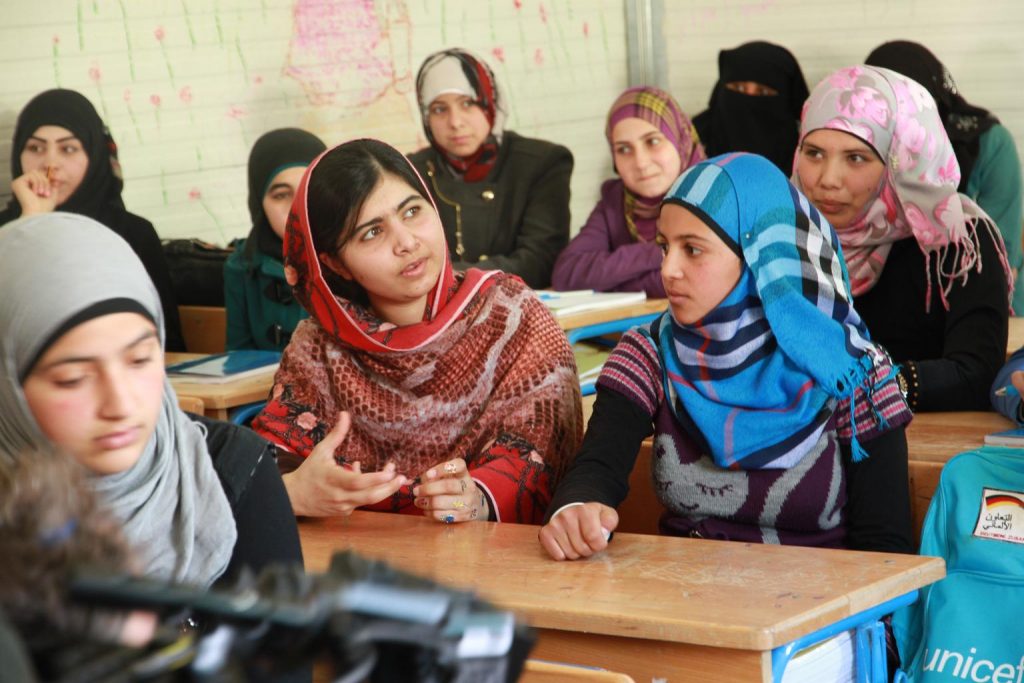
Education activist Malala Yousafzai of Pakistan speaks with students at School No. 2 in the Za’atari camp for Syrian refugees.
In a world that is rapidly advancing forward, society must also move with it. Part of this effort to advance as a world is rooted in the topic of women’s education.
The World Bank explains that women’s education is a developmental priority. Women who are educated tend to have better knowledge about nutrition, healthcare and are more likely to participate in formal labor markets to attain higher-income jobs. Women’s education provides a myriad of different benefits, not only for women, but for entire nations, and ultimately the whole world.
Benefits to Health and Knowledge
It has been estimated that an additional year of schooling for 1,000 women helps prevent two maternal deaths. This stems from basic information that women can learn in school and apply to their own lives. Furthermore, in Burkina Faso, mothers with secondary education are twice as likely to give birth more safely in health facilities as those with no education. Education has a direct connection with saving lives, emphasizing its importance for everyone.
Improving Mortality Rates
Studies have shown that a child born to a mother who can read is 50 percent more likely to survive past the age of 5 than a child born to an illiterate woman, proving that education can decrease childhood mortality.
Economic Support
A single year of primary school has been shown to increase women’s wages later in life by 10 percent to 20 percent, while the returns to female secondary education are between 15 percent and 25 percent. This is incredibly important, as, with our fast-paced economy and rapidly growing industries, we need to help women get access to higher-paying jobs in order to be able to survive. Increasing women’s access to jobs and the market through education is beneficial, as increased educational attainment accounts for about 50 percent of the economic growth in OECD countries over the past 50 years. Not only do we see higher wages for women, meaning they can better support their own families, we also see national economic growth.
Unfortunately, even with our changing times, there are many impediments to access to education for women. A study by UNESCO estimated that around 132 million girls worldwide are out of school. These obstacles include conflict and violence, harassment, and child marriage. But the biggest obstacle is probably poverty. Historically, poverty has been the most important factor that determines whether or not a girl can access education. However, there are ways that we can fix this issue.
First, we can support local organizations.
One incredible effort to increase women’s education access is being made by an Indonesian company known as Du Anyam. Du Anyam, a self-sustaining social enterprise, works to help communities through empowerment, education, and aid. One way that they’ve helped is through providing sustainable alternative cash access through wicker crafts production. Furthermore, they help empower women, both educationally and economically, through a series of vocational training, financial literacy, and digital literacy training as well as English courses.
Other organizations such as NGOs like UNICEF, are also making efforts in order to decrease educational gaps and increase gender equality. UNICEF donates money to nations, aids their governments in creating more gender-balanced and equal policies, and works to address issues such as distance-related barriers to education, re-entry policies for young mothers, and menstrual hygiene management in schools. By supporting organizations like Du Anyam and UNICEF, we can work to bring access to quality education for everyone worldwide while reducing inequality.
Prioritizing women’s access to education is critical in order to move forward as a society. While there are many other important issues, many of these are actually solved once access to education is improved. At the end of the day, giving hope to young girls worldwide is the best thing we can do to create a better and brighter future for generations to come.
Sources:
https://www.worldbank.org/en/topic/girlseducation
https://www.unicef.org/education/girls-education
https://www.usaid.gov/empowering-women-and-girls
https://www.prb.org/resources/the-effect-of-girls-education-on-health-outcomes-fact-sheet/ https://www.globalcitizen.org/en/content/barriers-to-girls-education-around-the-world/

